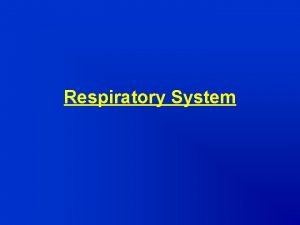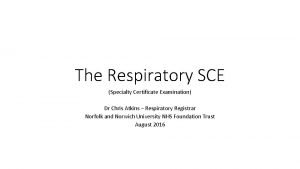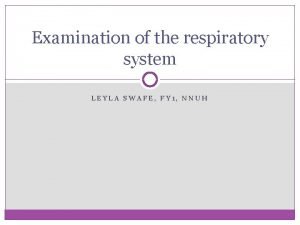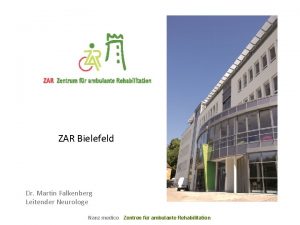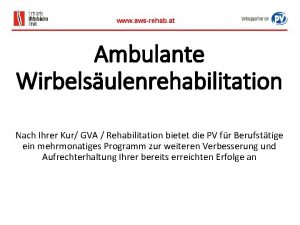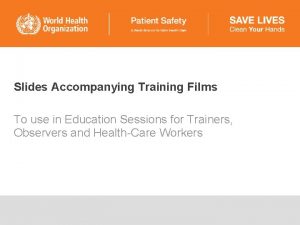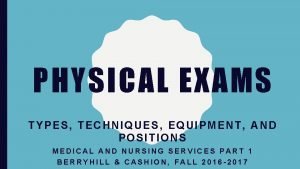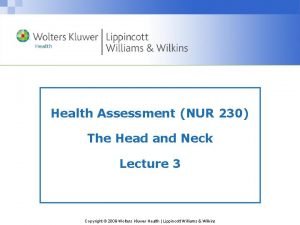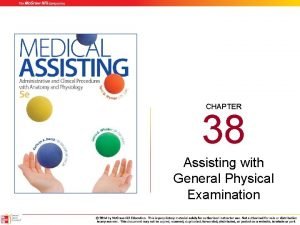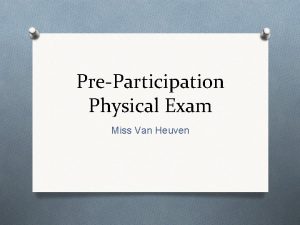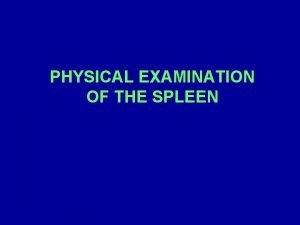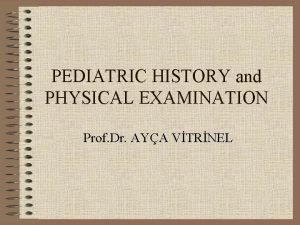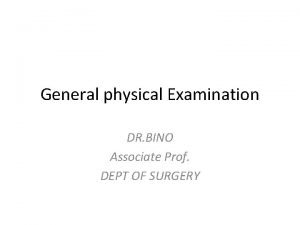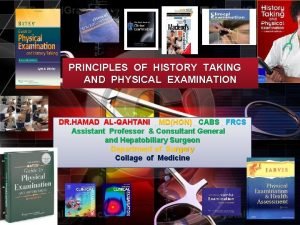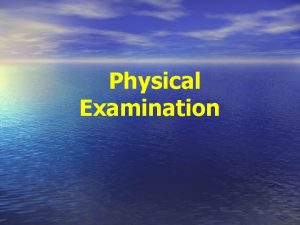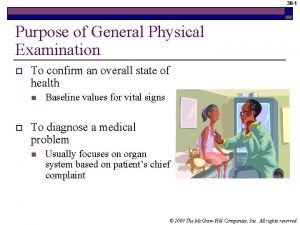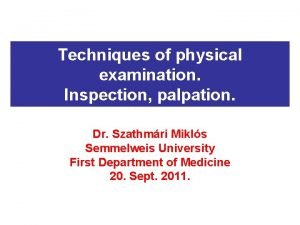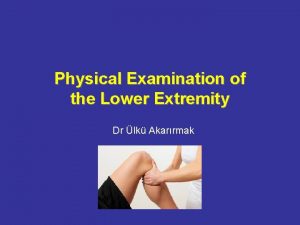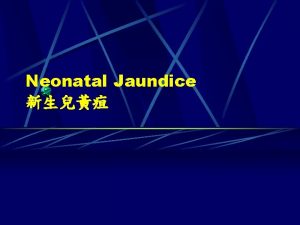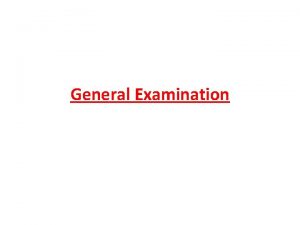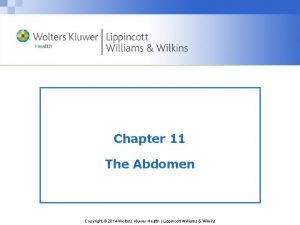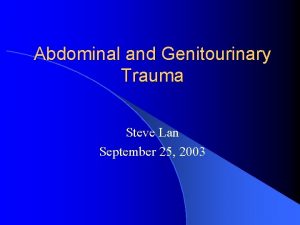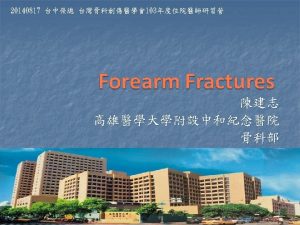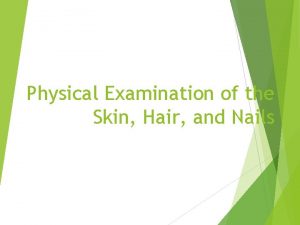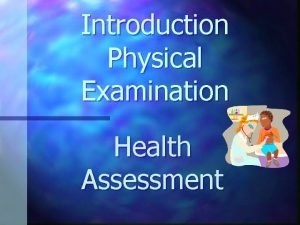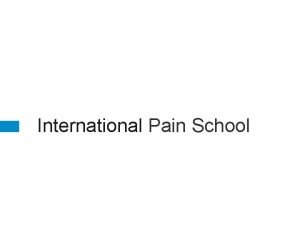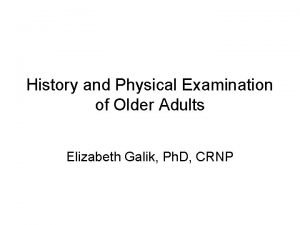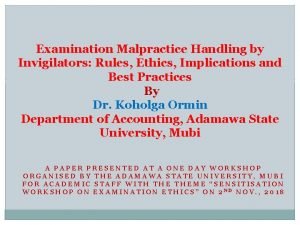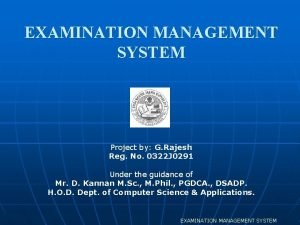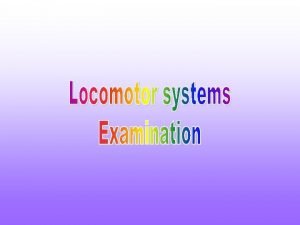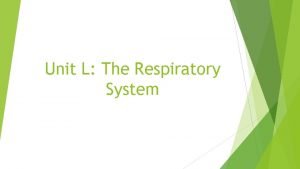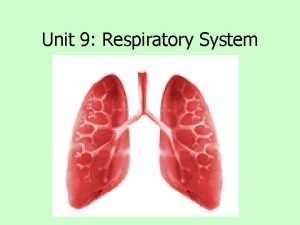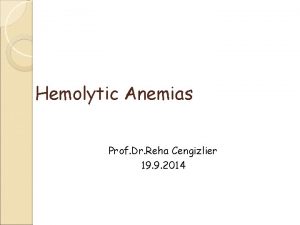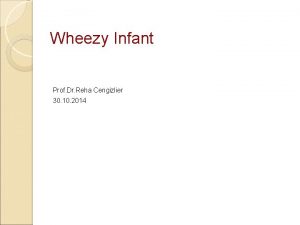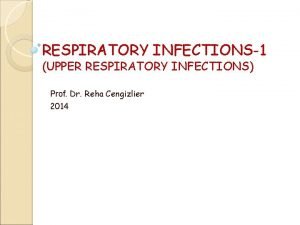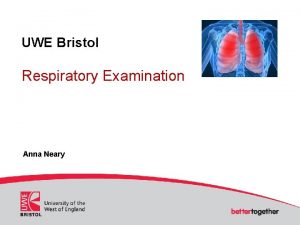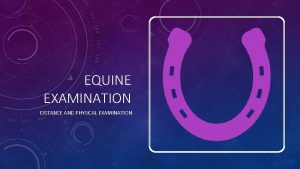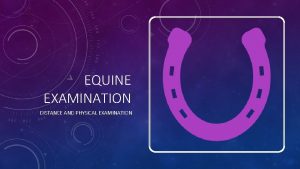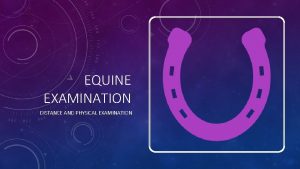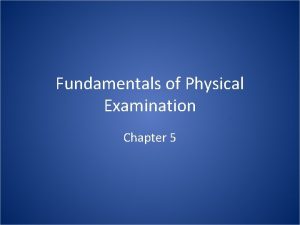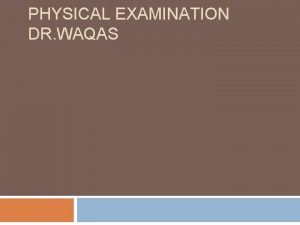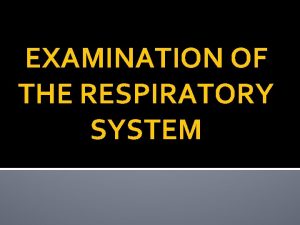RESPIRATORY SYSTEM PHYSICAL EXAMINATION Prof Dr Reha Cengizlier

















































- Slides: 49

RESPIRATORY SYSTEM – PHYSICAL EXAMINATION Prof. Dr. Reha Cengizlier 8. 9. 2014

Solunum sistemi muayenesi Amaç: • Öğrencilerin solunumun; – Özelliklerini – Normal ve anormal bulguların ayırımını – Muayene bulguları ile tanıya yaklaşmasını – Patolojik solunum seslerinin oluşma mekanizmasını ve – İsimlendirmeyi öğrenmesi

Solunum sistemi muayenesi Hedef • Bilgi ve beceri: – Solunum sisteminin bölümlerini sayabilmeli – Muayene yöntemlerini sayabilmeli – Patolojik solunum seslerinin oluş mekanizmasını anlatabilmeli – Patolojik solunum seslerini sayabilmeli – Belli hastalıklara tanı koyduran tipik solunum seslerini söyleyebilmeli – Solunum sistemi muayenesinin nasıl yapıldığını düzenli olarak anlatabilmeli

Solunum sistemi muayenesi • Tutum: – Doğru tanıya ve tedaviye giden yolun en önemli aşamalarından biri olarak muayenenin önemini kavramalı




Inspection General inspection: – Evidence of respiratory distress at rest or when walking, e. g. obvious breathlessness, talking in short phrases rather than full sentences, use of accessory muscles, exhalation with pursed lips – Evidence of other respiratory symptoms, e. g. cough, audible wheeze – Does the patient appear to be pyrexial (check their temperature)

Inspection Hands, Face and Neck – Finger clubbing – Cyanosis-(perypheral or central) – General appearance, e. g. Cushingoid as a result of long-term use of steroids – Anemia (conjunctiva) – Goitre (any possible tracheal obstruction) – Lymphadenopathy





Inspection Chest • Chest shape: – Overinflated (severe acute asthma) – Asymmetry (the abnormality is on the side that moves less, e. g. pneumothorax, collapse, consolidation or effusion) – Other abnormalities include pigeon chest (pectus carinatum), funnel chest (pectus excavatum), kyphosis and/or scoliosis – Respiratory rate • Operation scars • Paradoxical chest movement may indicate a fractured rib








Respiratory rate Newborn 1 mo-1 yr 1 -5 yrs 5 -12 yrs >12 yrs 40 (30 -60) 25 -35 20 -30 20 -25 16 -20


Dyspnea • Exaggerated use of accessory muscles • Intercostal, supraclavicular, and subcostal retractions • Flaring of nostrils • Tachypnea

Breathing patterns • Apnea: Respiratory arrest longer than 15 (20) sec; generally bradicardia and cyanosis accompanies • Periodic respiration: In preterm babies; in the first days of life, repeating respiratory arrest attacks, shorter than 20 sec.

Breathing patterns • Cheyne-Stokes: Progressively deeper breathing followed by temporary apnoea, which may occur with heart failure, cerebrovascular disease, head injury, carbon monoxide poisoning or brain tumors, or be a normal variant during sleep or at high altitude • Ortopnea: Breathing only in upright position (heart failure ) • Bradypnea: Low frequence breathing (metabolic alkalosis and CNS depression) • Hyperpnea: Rapid deep breathing

Breathing patterns • Hypopnea: Slow and shallow breathing • Kussmaul: Deep and rapid breathing, (often associated with severe metabolic acidosis) • Paradoxical: Inspiratory depression of thorax (intercostal muscle paralysis, URT obstruction, preterm baby)


Auscultation • • Infants; in arms Children; upright position Hands over head for axillar area ( big children) Ask the children to take deep breaths in and out with their mouth open • Infants are better audible while crying • Place the stethoscope over each of the 5 lobes of the lungs in turn, on the front and back of the chest

Auscultation • Normal breath sounds are called vesicular • They are described as quiet and gentle • There is usually no gap between the inspiratory and expiratory phase sounds • If; – Inspirium is longer (normal) – Expirium is longer (obstructive problem)

Pay attention to; • Inspirium-expirium relationship • Adititonal sounds • Dispersion of breathing sounds

Auscultation • Pathologic sounds – Rales: Generally inspiratory • Coarse (Trcheitis, bronchitis) • Sucrepitan (Bronchitis, bronchiolitis, bronchectasis, tbc) • Crepitan (Pneumonia, pulmonary congestion, edema) – Rhonchi: Generally expiratory • Sonor (ronflan rale) (Foreign body aspiration, Asthma, bronchitis) • Sibilan (wheezing, sibilan rale)(Asthma, bronchiolitis, cystic fybrosis)

Patolojik solunum sesleri Raller Kaba raller Ronküsler İnce raller (Krepitan) Orta raller (sub krepitan, sukrepitan) Sonor ronküs Sibilan ronküs (Sibilan ral) (Wheezing)




Auscultation • Rales (sometimes called crackles): – Probably represent opening of small airways and alveoli – They may be normal at the lung bases if they clear on coughing or after taking a few deep breaths – Typical finding of bronchopneumonia – Basal rales are a classical feature of pulmonary congestion with left ventricular failure – May be more diffuse in pulmonary fibrosis

Auscultation • Rhonchi (wheezes): – Musical sound heard on expiration. In severe cases they may be both inspiratory and expiratory. Imply narrowing of the airways – The loudness of rhonchi gives no indication of the severity of the condition – Typical in; Bronchial asthma and bronchiolitis

Auscultation • Tuber sufl: – Generated by turbulent air flow in large airways (similar sounds can be heard in healthy patients by listening over the trachea) – Sounds are harsh and poor in nature. Unlike normal vesicular breath sounds, there is a gap between the inspiratory and expiratory phase sounds – Bronchial breathing suggests consolidation or fibrosis, which permits the sound to be conducted more effectively to the chest wall

Auscultation • Pleural rub (=frotman): A creaking sound caused by stiff pleural membranes such as with pleurisy • Stridor: harsh inspiratory sound caused by partial obstruction of a large airway

Auscultation • Vocal resonance: – Place the stethoscope at various levels over the back and ask the patient to whisper “ 41 -42" each time. Note how well the sound is transmitted – The sound is muffled over a normal lung, increased if there is consolidation, and decreased or absent if there is effusion or collapse • Whispering pectoriloquy: – Is elicited as for vocal fremitus but ask the patient to whisper "one, two, three" – Whispering pectoriloquy is the increased quality and loudness of whispers that are heard with a stethoscope over an area of lung consolidation

Palpation • Use the index finger to feel the trachea and to determine whether the trachea feels central or is deviated – The trachea is deviated away from pneumothorax and effusion and towards collapse and consolidation – The trachea may also be deviated by a mass, e. g. enlarged lymph nodes

Palpation • Chest expansion: – Usual chest expansion in an adult is 4 -5 cm and should be symmetrical – Symmetrical reduction: overinflated lungs (e. g. bronchial asthma, emphysema), stiff lungs (e. g. pulmonary fibrosis), ankylosing spondylitis. – Asymmetrical reduction of chest wall expansion: absent expansion (e. g. empyema and pleural effusion) or reduced expansion (e. g. pulmonary consolidation and collapse)

Palpation • Tactile vocal fremitus: – To assess tactile vocal fremitus, use the ulnar side of the hand, by the hypothenar eminence with the palms facing upwards. Place it at various levels over the back, each time asking the patient to say "ninety-nine". Note how the sound is transmitted to the hand – Tactile vocal fremitus is increased over areas of consolidation and decreased or absent over areas of effusion or collapse • Feel for the apex beat of the heart; it will be displaced if the mediastinum is displaced or distorted


Percussion • For percussion of the chest, it is usual to use the middle finger of the dominant hand to do this • The chest is percussed by placing the nondominant hand on the chest and using the dominant middle finger to tap the other middle finger over the middle phalanx • A hyper-resonant sound suggests hyperinflation or a pneumothorax • A dull sound is easier to distinguish from normal. It may suggest collapse or consolidation, or a pleural effusion


Percussion • Dullness – – – Plural fluid Consolidation Wide atelectasis Tumor Pleural thickening • Hypersonor – Pneumothorax) – Obstructive disease • Asthma • Bronchiolitis • Emphysema

RESULT • • • Quiet environment Child’s at least upper body naked With a trusted parent Be patient EXPERIENCE IS VERY IMPORTANT AUSCULT, AUSCULT
 Reha cengizlier
Reha cengizlier Systemic examination of respiratory system
Systemic examination of respiratory system Respiratory zone of the respiratory system
Respiratory zone of the respiratory system Respiratory digestive and circulatory system
Respiratory digestive and circulatory system Sce respiratory medicine
Sce respiratory medicine Supraclavicular fossa
Supraclavicular fossa Zar bielefeld
Zar bielefeld Geriatrische zorgvrager
Geriatrische zorgvrager Reha groten würselen
Reha groten würselen Aws-rehab.at
Aws-rehab.at Anu reha
Anu reha Kilihan
Kilihan Schulische reha
Schulische reha Integumentary system physical examination
Integumentary system physical examination How respiratory system work with circulatory system
How respiratory system work with circulatory system Circulatory system and respiratory system work together
Circulatory system and respiratory system work together Physical examination tray
Physical examination tray Physical examination equipment
Physical examination equipment Abbott nutrition focused physical assessment
Abbott nutrition focused physical assessment Focused gi assessment
Focused gi assessment Bates guide to physical examination
Bates guide to physical examination Assisting with a general physical examination
Assisting with a general physical examination Office-based pre-participation physical examination
Office-based pre-participation physical examination Traube space percussion
Traube space percussion Sneezing
Sneezing Obrunded
Obrunded Principles of physical examination
Principles of physical examination Physical examination definition
Physical examination definition General physical exam
General physical exam Mathes nahai
Mathes nahai Physical exam abdomen
Physical exam abdomen Myotomes ll
Myotomes ll Jaundice physical examination
Jaundice physical examination General appearance in physical examination
General appearance in physical examination Physical examination techniques
Physical examination techniques Hemoperitoneum symptoms
Hemoperitoneum symptoms N
N Conclusion of physical examination
Conclusion of physical examination Bulla skin
Bulla skin Physical examination introduction
Physical examination introduction Painad
Painad Physical examination conclusion
Physical examination conclusion Buerger test
Buerger test Conclusion of physical examination
Conclusion of physical examination Function of male reproductive system
Function of male reproductive system College examination management system
College examination management system Vutes
Vutes Locomotor system examination
Locomotor system examination Respiratory system bozeman
Respiratory system bozeman Unit 9 respiratory system
Unit 9 respiratory system

